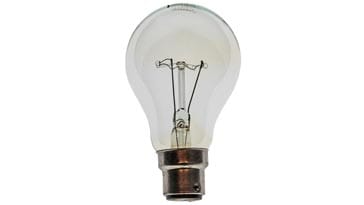Resistance of a Filament Lamp: why is it Non-Ohmic
The resistance of a filament lamp or bulb changes with the temperature of the filament as the potential across it increases and this means it is non-Ohmic.
Resistance Tutorial Includes:
What is resistance
Ohms Law
Ohmic & Non-Ohmic conductors
Resistance of filament lamp
Resistivity
Resistivity table for common materials
Resistance temperature coefficient
Voltage coefficient of resistance, VCR
Electrical conductivity
Series & parallel resistors
Parallel resistors table
Understanding the resistance of a filament lamp or bulb and why it changes gives insights into a variety of electrical and electronic components that are classed as non-Ohmic.
Knowing whether items are Ohmic or non-Ohmic can play a large part in electrical and electronic circuit design and understanding the reasons for these properties can give more insight into their operation.
Incandescent or filament lamps are a key example of an electrical or electronic component that is non-Ohmic. Understanding why these filament lamps are non-Ohmic enables them to be used more appropriately.

What is a non-Ohmic conductor
Before looking a little more closely at incandescent lamps or filament lamps and why they are non-Ohmic, it is worth recapping what a non-Ohmic conductor is.
Essentially a non-Ohmic conductor or component is one that does not follow Ohms law. In other words if the voltage is doubled the current will not double.
In other words there is not a linear relationship between the voltage and current and a graph of the current and voltage would not be a straight line.
What are filament lamps / incandescent lamps
The incandescent light bulb is a prime example of a non-ohmic conductor, and they are used to demonstrate the non-Ohmic response in many experiments.
Filament lamps, also called incandescent lamps, are not widely used these days because they are very inefficient in terms of their conversion of electrical energy to light energy. Typically they convert less than 5% or the power entering them into light. The remainder is dissipated as heat. With modern LED lamps being as much as 85% efficient, LEDs offer a far better option for lighting.
The filament lamp consists of a coiled wire filament held on posts within a glass bulb. The filament is normally very thin and as a result it is able to offer a reasonable level of resistance. In turn this means that with a potential difference applied and current flowing though it, heat will be disipated.
The level of heat dissipated within the filament, raises the temperature significantly, and the filament glows white hot - this is what generates the light that is emitted.
Check out our video about the Resistance of a Filament Lamp
Why a filament lamp is non-Ohmic
The reason for the non-Ohmic characteristic results from the heat generated by the filament of the lamp.
For normal operation a lamp will be powered by a battery as in the case of a torch, or from the mains power lines for domestic or industrial lighting.
These power sources provide an almost constant voltage and it can be assumed this remains the same all of the time.
When first turned on, the lamp has a low resistance: a domestic lighting lamp will have a resistance of a few Ohms. As a result there will be a large inrush of current.
This means that the filament becomes very hot, very quickly - it is heated to white heat.
However with the increase in temperature, the resistance also rises so that the current reduces and the lamp settles to normal operation.
If the I V characteristic was to be measured and plotted for various voltages, then it would be found that for low voltages the resistance would be low and the current would be high for the voltage applied. As the potential difference across a filament lamp is increased, the current increases and the energy dissipated, as heat, increases, resulting in a filament operating at a higher temperature. As the temperature increases, resistance of the filament also increases.

Note that the graph of the resistance of the filament lamp has both positive and negative elements to it. This is because the voltage can be applied in either sense and the same performance will be seen.
As the filament within an incandescent lamp heats up, there is a significant change in the resistance between the off state and when it is operating. A typical 60W bulb operating at 250 volts will consume 0.24 amps and have a resistance of 1041Ω or thereabouts. When measured using a digital multimeter the resistance is just a few Ohms because the filament will be cold.
The reason for this change is that when the filament is operating at room temperature with only a small potential difference applied, the electrons are able to flow through it relatively easily. They have sufficient energy to be drawn through the filament wire.
However, when the filament is at its operating temperature, the electrons have a large amount of energy as a result of the very high temperature. This means that they are unable to flow through the lattice int he wire smoothly and hence their flow is impeded, and the resistance to the current flow is significantly increased.
A filament lamp or incandescent light bulb provides an excellent example of a non-Ohmic component. Its resistance is low for low potential differences and it rises as the voltage increases and the temperature of the filament rises.
 Written by Ian Poole .
Written by Ian Poole .
Experienced electronics engineer and author.
More Basic Electronics Concepts & Tutorials:
Voltage
Current
Power
Resistance
Capacitance
Inductance
Transformers
Decibel, dB
Kirchoff's Laws
Q, quality factor
RF noise
Waveforms
Return to Basic Electronics Concepts menu . . .




